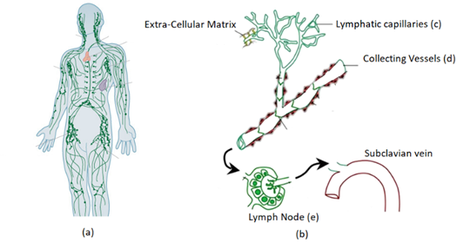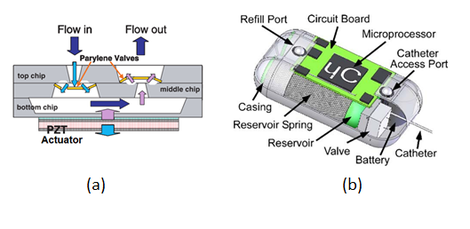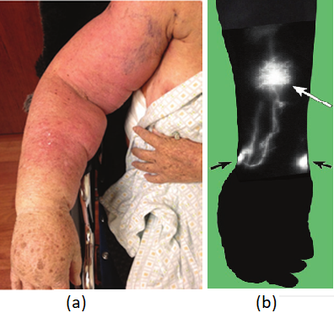Design and fabrication of a new implantable piezoelectric micropump for the treatment and management of lymphedema
Problem definition and state of the art
The lymphatic system is critically important for immune surveillance, lipid absorption and, in general, the mass transport from the interstitium (space between cells and matrix proteins) back into the cardiovascular (venous) circulation. The lymphatic system is a complex network organized as a vessel tree (Fig. 1). The lymphatic capillaries are the smallest vessels and play a crucial role in collecting the interstitial fluid from the interstitium (lymph formation). Lymph is further propelled through the lymphatic channel towards the larger collecting lymphatics, organized in a series of lymphangions. These are delimited by valves, where an active mechanism of contractions transports the lymph to larger lymphatic trunks, the right lymphatic duct and the thoracic duct, which bring the lymph into the right and left subclavian vein, respectively.

One possible consequence of inadequate lymph transport is lymphedema, in which protein-rich interstitial fluid accumulates in the tissues, leading to inflammation, fatty tissue proliferation, fibrosis and tissue swelling (Fig. 2). Therefore, the major goal of this project is the design and development of a new implantable microfluidics system to facilitate the interstitial fluid drainage as a structural treatment of acquired lymphedema.

In this project, a novel microfluidic pump (Figure 3) will be fabricated to be used as an artificial implantable bypass for the treatment of lymphedema. This will help to achieve a higher and more controllable lymphatic clearance of the excess interstitial fluid accumulated in the limbs of patients suffering from lymphedema. When successful, this project will provide surgeons with an alternative for the current surgical techniques that are associated with complications and comorbidities. Besides the application as an implantable device, we also see a large potential of the device for new tissue engineering strategies for the treatment of lymphedema with in-vitro cultivation of lymph vessels and lymph nodes. The microfluidic pump could be used as an in vitro platform for reproducing the stresses imposed to the lymph nodes in the in-vivo setting. Traditional in vitro experiments that rely on migration and transmigration assays do not recapitulate the multiple factors that affect lymphatic function. In an effort to better match the size dimensions, mechanical forces, and fluid forces in the lymphatic microenvironment, scaffolds with controlled microfluidic pumps can be used to simulate in vivo lymphatic biomechanics.
Furthermore, lymphatic micropumps can be employed in Organ-on-a-chip assays for drug development and specialized diagnostic applications. Complex microsystems can be developed directly on a microfluidic device with this micropump to recreate an organ’s physiology. The micropump can also be used as powerful tool to generate required flow in point of care devices and in other advanced treatments which requires small doses and high accuracy.
This project is a joint project of the IBiTech-bioMMeda group (Biofluid, Tissue and Solid Mechanics for Medical Applications) and the CMST group (Imec) with expertise in the design and microfabrication of microfluidic devices. The project finds its origin in an FWO research project, (Ir. Ghazal Adeli Koudehi - 3D Models of lymphangions and microlymphatics G022117N), ongoing within IBiTech-bioMMeda, within which we are studying the fundamental principles of mass transport in the lymphatic system, a.o. to better understand lymphedema. This project, however, adds a new dimension to the research of the group, setting a step towards a therapeutic solution for the disease. Both groups are embedded within the Department of Electronics and Information Systems at Ghent University, and have a highly compatible expertise. We anticipate a growing use of implantable miniature devices and sensors, and a structural collaboration between these two complementary groups is of great importance and strategic value for both.
IBiTech researchers currently active on the project
- Carlos Alejandro Silvera Delgado (contact)
- Patrick Segers (contact)
- Charlotte Debbaut (contact)
- Jan Vanfleteren (contact)
- Rik Verplancke (contact)
Funding sources
- FWO 1SC2619N - Design and fabrication of a new implantable piezoelectric micropump for the treatment and management of lymphedema (Carlos Alejandro Silvera Delgado)
- FWO G022117N - Multi-scale modelling of interstitial-to-lymphatic mass transport for the study of edema and trans-lymphatic drug administration (Patrick Segers, Charlotte Debbaut & Pieter Cornillie)
Bibliography
- Microengineering Approach for Directing Embryonic Stem Cell Differentiation. Bae, Hojae, et al. September 2010, 2010, Biomaterials As Stem Cell Niche, Vol. 2, pp. 153-171. 10.1007/8415.
- Micropump based on PZT unimorph and one-way parylene valves. Feng, Guo Hua and Kim, Eun Sok. 4, 2004, Journal of Micromechanics and Microengineering, Vol. 14, pp. 429-435. 10.1088/0960-1317/14/4/001.
- Financial cost of lymphedema borne by women with breast cancer. Boyages, John, et al. 6, 2017, Psycho-Oncology, Vol. 26, pp. 849-855. 10.1002/pon.4239.
- A Normally-Closed All Polymer Flexible Micro valve for Drug Delivery and In-Vivo Applications. Jahanshahi, Amir, Salvo, Pietro and Vanfleteren, Jan. pp. 1-19
- Lymphedema - Lymphology Clinic of Brussels - Saint-Pierre University Hospital.
Relevant links



